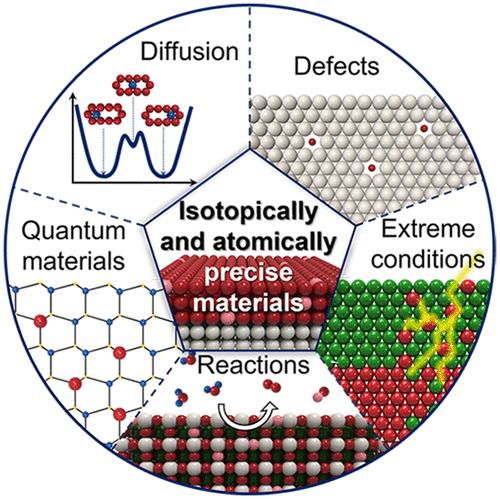当前位置:
X-MOL 学术
›
Acc. Mater. Res.
›
论文详情
Our official English website, www.x-mol.net, welcomes your
feedback! (Note: you will need to create a separate account there.)
Synthesis, Processing, and Use of Isotopically Enriched Epitaxial Oxide Thin Films
Accounts of Materials Research ( IF 14.0 ) Pub Date : 2024-08-08 , DOI: 10.1021/accountsmr.3c00148 Tiffany C. Kaspar 1 , Yingge Du 1
Accounts of Materials Research ( IF 14.0 ) Pub Date : 2024-08-08 , DOI: 10.1021/accountsmr.3c00148 Tiffany C. Kaspar 1 , Yingge Du 1
Affiliation

|
Isotopic engineering has emerged as a key approach to study the nucleation, diffusion, phase transitions, and reactions of materials at an atomic level. It aims to uncover mass transport pathways, kinetics, and operational and failure mechanisms of functional materials and devices. Understanding these phenomena leads to deeper insights into important physical processes, such as the transport of ions in energy conversion and storage devices and the role of active sites and supports during heterogeneous catalytic reactions. Likewise, isotopic engineering is being pursued as a means of modifying functionality to enable future technological applications. In this Account, we summarize our recent work employing isotope labeling (e.g., 18O2 and 57Fe) during thin film synthesis and postgrowth processing to reveal growth mechanisms, defect chemistry, and elemental diffusion under working and extreme conditions. Isotope-resolved analysis techniques with nanometer-scale spatial resolution, such as time-of-flight secondary ion mass spectrometry and atom probe tomography, facilitate the accurate quantification of isotopic placement and concentration in our well-defined heterostructures with precisely positioned, isotope-enriched layers. By measuring the nanometer-scale redistribution between natural abundance and isotopically enriched oxygen layers during the deposition of Fe2O3 and Cr2O3 by molecular beam epitaxy, we identified intermixing processes driven by surface adatoms occurring both at the film growth surface and within the first few layers below the surface. Further insights into synthesis mechanisms were gained by studying the tungsten oxide thin films grown by evaporating WO3 powder in the presence of background 18O2, revealing minimal incorporation of background oxygen during the film formation process. Thermal and radiation-enhanced diffusion in epitaxial Fe and Cr oxides were precisely tracked using 18O and 57Fe tracer layers incorporated into model epitaxial oxide thin films. This approach has allowed us to access thermal diffusion behavior at lower temperatures than previously measured, revealing a potential changeover in diffusion mechanism. Understanding radiation-enhanced diffusion in model oxides that represent the surface layers on the structural components of nuclear reactors informs our understanding of their corrosion behavior under irradiation. Isotopic labeling can also provide unique insights into the surface exchange reactions and defect chemistry of electrocatalysts. For instance, tracking the change in 18O concentration at the surface of an epitaxial LaNiO3 thin film after the electrocatalytic oxygen evolution reaction revealed the participation of lattice oxygen, confirming a hypothesis that had been proposed previously. Lastly, we highlight a new direction wherein we perform in situ processing studies utilizing isotopic tracers in conjunction with model epitaxial thin films within the atom probe tomography instrument. This Account illustrates the great potential of isotopic engineering to enable fundamental mechanistic insights into physical processes and engineer functional properties in epitaxial films, heterostructures, and superlattices.
中文翻译:

富同位素外延氧化物薄膜的合成、加工和使用
同位素工程已成为在原子水平上研究材料的成核、扩散、相变和反应的关键方法。它的目的是揭示功能材料和设备的质量传输路径、动力学以及操作和故障机制。了解这些现象可以更深入地了解重要的物理过程,例如能量转换和存储装置中的离子传输以及多相催化反应中活性位点和载体的作用。同样,同位素工程也被视为修改功能以实现未来技术应用的一种手段。在本报告中,我们总结了我们最近在薄膜合成和生长后处理过程中采用同位素标记(例如18 O 2和57 Fe)的工作,以揭示工作和极端条件下的生长机制、缺陷化学和元素扩散。具有纳米级空间分辨率的同位素解析分析技术,例如飞行时间二次离子质谱和原子探针断层扫描,有助于准确量化我们定义明确的异质结构中的同位素位置和浓度,这些异质结构具有精确定位的同位素富集层。通过分子束外延沉积 Fe 2 O 3和 Cr 2 O 3过程中测量自然丰度和同位素富集氧层之间的纳米级重新分布,我们确定了由发生在薄膜生长表面和内部的表面吸附原子驱动的混合过程。地表以下的前几层。 通过研究在背景18 O 2存在下蒸发 WO 3粉末生长的氧化钨薄膜,获得了对合成机制的进一步了解,揭示了在薄膜形成过程中背景氧的最少掺入。使用并入模型外延氧化物薄膜中的18 O 和57 Fe 示踪剂层精确跟踪外延 Fe 和 Cr 氧化物中的热和辐射增强扩散。这种方法使我们能够在比之前测量的温度更低的温度下获得热扩散行为,揭示扩散机制的潜在转变。了解代表核反应堆结构部件表面层的模型氧化物中的辐射增强扩散有助于我们了解其在辐照下的腐蚀行为。同位素标记还可以为电催化剂的表面交换反应和缺陷化学提供独特的见解。例如,跟踪电催化析氧反应后外延LaNiO 3薄膜表面18 O浓度的变化揭示了晶格氧的参与,证实了之前提出的假设。最后,我们强调了一个新方向,即利用同位素示踪剂与原子探针断层扫描仪器内的模型外延薄膜相结合进行原位处理研究。本报告说明了同位素工程的巨大潜力,可以从根本上深入了解物理过程,并设计外延膜、异质结构和超晶格的功能特性。
更新日期:2024-08-08
中文翻译:

富同位素外延氧化物薄膜的合成、加工和使用
同位素工程已成为在原子水平上研究材料的成核、扩散、相变和反应的关键方法。它的目的是揭示功能材料和设备的质量传输路径、动力学以及操作和故障机制。了解这些现象可以更深入地了解重要的物理过程,例如能量转换和存储装置中的离子传输以及多相催化反应中活性位点和载体的作用。同样,同位素工程也被视为修改功能以实现未来技术应用的一种手段。在本报告中,我们总结了我们最近在薄膜合成和生长后处理过程中采用同位素标记(例如18 O 2和57 Fe)的工作,以揭示工作和极端条件下的生长机制、缺陷化学和元素扩散。具有纳米级空间分辨率的同位素解析分析技术,例如飞行时间二次离子质谱和原子探针断层扫描,有助于准确量化我们定义明确的异质结构中的同位素位置和浓度,这些异质结构具有精确定位的同位素富集层。通过分子束外延沉积 Fe 2 O 3和 Cr 2 O 3过程中测量自然丰度和同位素富集氧层之间的纳米级重新分布,我们确定了由发生在薄膜生长表面和内部的表面吸附原子驱动的混合过程。地表以下的前几层。 通过研究在背景18 O 2存在下蒸发 WO 3粉末生长的氧化钨薄膜,获得了对合成机制的进一步了解,揭示了在薄膜形成过程中背景氧的最少掺入。使用并入模型外延氧化物薄膜中的18 O 和57 Fe 示踪剂层精确跟踪外延 Fe 和 Cr 氧化物中的热和辐射增强扩散。这种方法使我们能够在比之前测量的温度更低的温度下获得热扩散行为,揭示扩散机制的潜在转变。了解代表核反应堆结构部件表面层的模型氧化物中的辐射增强扩散有助于我们了解其在辐照下的腐蚀行为。同位素标记还可以为电催化剂的表面交换反应和缺陷化学提供独特的见解。例如,跟踪电催化析氧反应后外延LaNiO 3薄膜表面18 O浓度的变化揭示了晶格氧的参与,证实了之前提出的假设。最后,我们强调了一个新方向,即利用同位素示踪剂与原子探针断层扫描仪器内的模型外延薄膜相结合进行原位处理研究。本报告说明了同位素工程的巨大潜力,可以从根本上深入了解物理过程,并设计外延膜、异质结构和超晶格的功能特性。


















































 京公网安备 11010802027423号
京公网安备 11010802027423号